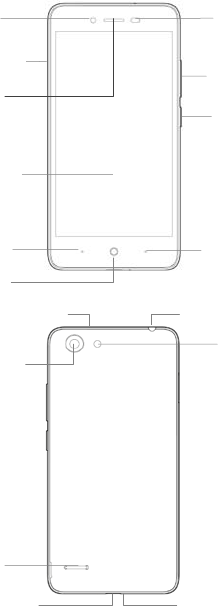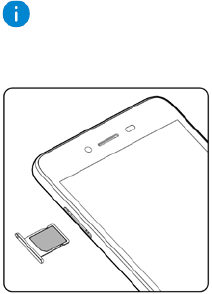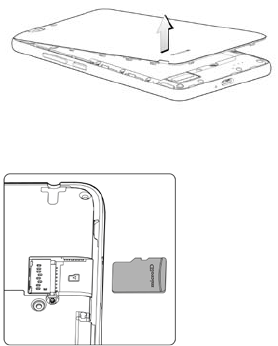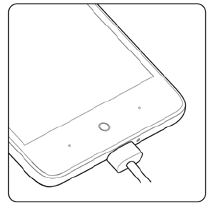ZTE Z861BL LTE Mutil-Mode Digital Mobile Phone User Manual
ZTE Corporation LTE Mutil-Mode Digital Mobile Phone
ZTE >
Users Manual
ZTE Z861BL
User Manual

1
Your phone at a glance
Receiver
Light/proximity
sensor
Back key
Home key
Menu key
SIM card tray
Touch Screen
Front
camera
Volume
button
Power
button
Headset jack
Noise-reduction MIC
Back camera
Flash
USB type-C port
Speaker
Microphone

2
Inserting the SIM card
1. Insert the end of the eject tool into the hole of
the card tray and press firmly until the tray
pops out.
2. Put the nano-SIM card into the tray.
3. Push the card tray back into the phone.
Note
Your phone supports a nano-SIM card ONLY.
Dimensions of a nano-SIM card: 9mm*12mm

3
Inserting the memory card
1. Remove the back cover..
2. Insert the memory card into the memory card
slot.
3. Install the back cover.

4
Charging the battery
Connect the phone to the power outlet using the
included USB cable and power adapter.
5
Power on
Long press the Power button to power on the
mobile phone.

6
Declaration of RoHS Compliance
We’re determined to reduce the impact we have on
the environment and take responsibility for the earth
we live on. So this document allows us to formally
declare that the Z861BL, manufactured by ZTE
Corporation, fully complies with the European
Parliament’s RoHS (Restriction of Hazardous
Substances) Directive 2002/95/EC, with respect to all
the following substances:
(1) Lead (Pb)
(2) Mercury (Hg)
(3) Cadmium (Cd)
(4) Hexavalent Chromium (Cr (VI))
(5) Polybrominated biphenyl (PBB)
(6) Polybrominated diphenyl ether (PBDE)
Our compliance is witnessed by written declaration
from our suppliers. This confirms that any potential
trace contamination levels of the substances listed
above are below the maximum level set by EU
2002/95/EC, or are exempt due to their application.
The Z861BL manufactured by ZTE Corporation meets
all the requirements of EU 2002/95/EC.
Disposal of your old phone
1. When the wheelie bin symbol is
attached to a product, it means the
product is covered by the European
Directive 2002/96/CE.
2. All electrical and electronic products
should be disposed of separately from
normal household waste via designated collection
points provided by government or local authorities.
3. The correct disposal of electrical and electronic
products will help protect the environment and
human health.
7
Health and safety
FCC Regulations:
This mobile phone complies with part 15 of the FCC
Rules. Operation is subject to the following two
conditions: (1) This device may not cause harmful
interference, and (2) this device must accept any
interference received, including interference that
may cause undesired operation.
This mobile phone has been tested and found to
comply with the limits for a Class B digital device,
pursuant to Part 15 of the FCC Rules. These limits are
designed to provide reasonable protection against
harmful interference in a residential installation. This
equipment generates, uses and can radiated radio
frequency energy and, if not installed and used in
accordance with the instructions, may cause harmful
interference to radio communications. However,
there is no guarantee that interference will not occur
in a particular installation If this equipment does
cause harmful interference to radio or television
reception, which can be determined by turning the
equipment off and on, the user is encouraged to try
to correct the interference by one or more of the
following measures:
-Reorient or relocate the receiving antenna.
-Increase the separation between the equipment and
receiver.
-Connect the equipment into an outlet on a circuit
different from that to which the receiver is
connected.
-Consult the dealer or an experienced radio/TV
technician for help.
8
FCC Note:
Caution: Changes or modifications not expressly
approved by the party responsible for compliance
could void the user‘s authority to operate the
equipment.
RF exposure information (SAR)
This phone is designed and manufactured not to
exceed the emission limits for exposure to radio
frequency (RF) energy set by the Federal
Communications Commission of the United States.
During SAR testing, this device was set to transmit at
its highest certified power level in all tested
frequency bands, and placed in positions that
simulate RF exposure in usage against the head with
no separation, and near the body with the separation
of 10 mm. Although the SAR is determined at the
highest certified power level, the actual SAR level of
the device while operating can be well below the
maximum value. This is because the phone is
designed to operate at multiple power levels so as to
use only the power required to reach the
network. In general, the closer you are to a wireless
base station antenna, the lower the power output.
The exposure standard for wireless devices
employing a unit of measurement is known as the
Specific Absorption Rate, or SAR.
The SAR limit set by the FCC is 1.6W/kg.
This device is complied with SAR for general
population /uncontrolled exposure limits in
ANSI/IEEE C95.1-1992 and had been tested
inaccordance with the measurement methods and
procedures specified in IEEE1528. This device has
been tested and meets the FCC RF exposure
guidelines when tested with the device directly
contacted to the body.
The FCC has granted an Equipment Authorization for
this model phone with all reported SAR levels

9
evaluated as in compliance with the FCC RF exposure
guidelines. SAR information on this model phone is
on file with the FCC and can be found under the
Display Grant section of www.fcc.gov/oet/ea/fccid
after searching on FCC ID: SRQ-Z861BL
For this device, the highest reported SAR value for
usage against the head is 0.713 W/kg, for usage near
the body is 1.258 W/kg. Hotspot SAR is 1.290W/kg,
Simultaneous SAR is 1.582W/kg.
While there may be differences between the SAR
levels of various phones and at various positions,
they all meet the government requirements.
SAR compliance for body-worn operation is based on
a separation distance of 10 mm between the unit and
the human body. Carry this device at least 10 mm
away from your body to ensure RF exposure level
compliant or lower to the reported level. To support
body-worn operation, choose the belt clips or
holsters, which do not contain metallic components,
to maintain a separation of 10 mm between this
device and your body.
RF exposure compliance with any body-worn
accessory, which contains metal, was not tested and
certified, and use such body-worn accessory should
be avoided.
This device does not support V.O.I.P. function. It
means that the functions of WLAN and Bluetooth do
not have voice capability in the held to ear mode for
phone service.

10
Using your phone safely
On the road
Using a phone while driving is illegal in many
countries. Please follow local laws and drive
safely at all times.
Near sensitive electronics
Don’t use your phone near sensitive
electronic equipment – particularly medical
devices such as pacemakers – as it could
cause them to malfunction. It can also
interfere with the operation of fire detectors
and other automatic-control equipment.
For more information about how your phone
affects pacemakers or other electronic
equipment, please contact the manufacturer
or your local distributor.
Your phone may cause interference when
used near TVs, radios or automated office
equipment.
While flying
Your phone can cause interference with
aircraft equipment. So it’s essential you
follow airline regulations. And if airline
personnel ask you to switch off your phone,
or disable its wireless functions, please do as
they say.
In hospital
Your phone may interfere with the normal
operation of medical equipment. Follow all
hospital regulations and turn it off when
you’re asked to by posted warnings or
medical staff.

11
At a petrol station
Don’t use your phone at petrol stations. In
fact, it’s always best to switch off whenever
you’re near fuels, chemicals or explosives.
Around water
Keep your phone away from water (or any
other liquid). It’s not a waterproof model.
Making repairs
Never take your phone apart. Please leave
that to the professionals. Unauthorised
repairs could break the terms of your
warranty.
Broken antenna
Don’t use your phone if the antenna is
damaged, as it could cause injury.
Please do not touch or cover the antenna
area (the upper part on the back of your
phone) during the conversation to avoid
affecting talk quality and consuming more
battery power, which might reduce the talk
time and standby time.
Around children
Keep your phone out of children’s reach. It
should never be used as a toy and it might
not be good for their health.
Original accessories
Only use the original accessories supplied
with your phone or those approved by the
manufacturer. Using unapproved accessories
may affect performance, make the warranty

12
void, break national regulations on the use of
phones, or even cause injury.
Near explosives
Turn off your phone in or near areas where
explosive materials are used. Always obey
local laws and turn off your phone when
requested.
Emergency calls
To make an emergency call your phone must
be turned on and in an area where there’s
network coverage. Dial the national
emergency number and touch ‘send’. Explain
exactly where you are and don’t hang up
until help has arrived.
Working temperature
The working temperature for the phone is
between 0℃ and 40℃. Please don’t use the
phone outside the range. Using the phone
under too high or too low temperature might
cause problems.
Eyesight
Please do not use your phone in dim light for
a long time to avoid damage on your
eyesight.
For some people, exposure to flashing lights
(such as TV) might trigger seizures or
dizziness. If you have a history of seizures or
epilepsy, consult a doctor before playing
video games or enabling a flashlight feature
on your phone.

13
Safety information
In order to protect your personal information
and prevent disclosure of sensitive
information, please set a phone password
and change it from time to time, make sure
to back up important data, back up the data
on your phone before disposal and reset your
phone.
Please do not download unknown
applications and browse suspected websites
in order to protect your phone against
malicious applications and viruses.
At very high volume, prolonged listening
to a phone can damage your hearing.
Charger care and safety
Only plug into voltages between 110VAC and
220VAC. Using a voltage outside that range
can damage the phone/charger – and cause
the battery to leak or catch fire.
Never short-circuit the charger – this may
cause electrocution, overheating or damage.
Don’t charge the phone in direct sunlight or
in an area where it’s damp, dusty, or on a
vibrating surface. And charging your phone
near – or on – a TV or radio could interfere
with transmission.
Don’t use the charger if the power cable is
damaged. It may cause a fire or give
someone an electric shock.
Keep water well away from the charger. If
the charger does get splashed by water, or
any other kind of liquid, immediately unplug
注意此处各国家可能不同
越南应改为 100 和240
14
it to avoid overheating, fire or electrocution.
Don’t take the charger apart. It could cause
injury, give you an electric shock or catch fire.
Never touch any charger, electric cable or
socket with wet hands.
Don’t place heavy objects on the electric
cable.
If the cable is damaged, don’t try to mend it
yourself – it could cause a fire or electrocute
you.
Always unplug the charger before you clean
it.
When unplugging the charger, hold the plug
itself, rather than pulling on the cable. A
damaged cable can cause electrocution or
fire.
15
Care and maintenance
Your phone is a delicate device. The following
advice will help you to keep it looking good and
performing well…
Use a soft dry cloth to clean your phone,
battery and charger. Don’t use liquids such as
alcohol, dilution agents or benzene.
From time-to-time, clean the socket where
the charger cable connects to the phone.
Dust tends to gather there. This will ensure a
really good connection.
Don’t use needles, pen points or other sharp
objects on the keypad or screen.
Don’t use your phone with wet hands – it
could injure you and damage the phone.
Don’t use your phone in dusty or dirty
environment.
Keep your phone away from extremes of
heat – like radiators or ovens. It may explode
if it gets too hot.
If your phone gets wet and the colour of the
label on it changes, the warranty will be void,
even if the warranty period hasn’t expired.
If there’s anything wrong with the phone,
battery, charger, or any accessory, please
send them to your nearest service centre for
inspection.
16
Legal notice
Copyright Statement
Copyright © 2016 by
All the copyrights of this document herein belong
to
ZTE Corporation
ZTE Corporation. Without the written permission
of copyright owner, no part of this publication may
be excerpted, reproduced, translated by any person
or entity in any form or by any means.
This document is subject to change without prior
notice.
ZTE Corporation
Trademarks
keeps the right to make the final
explanation to this document.
Android is a trademark of Google, Inc.
Statement of Third-party Applications
All other trademarks remain the property of their
respective owners.
During the installation process of some third-party
applications, the issues of repeated restart or
abnormal use of software might be caused by
incompatibility of the third-party applications, rather
than the phone itself.
This device complies with the FCC HAC requirements has also been tested E-Field, H-Field and
T-Coil, the worst test result of M rating is M4, the T rating is T3 for GSM850/1900, T4 for WCDMA
band II/IV/V.
M-Ratings: Phones rated M3 or M4 meet FCC requirements and are likely to generate less
interference to hearing devices than phones that are not rated. M4 is the better/higher of the
two ratings. Your device is rated M4.
T-Ratings: Phones rated T3 or T4 meet FCC requirements and are likely to be more usable with a
hearing aid’s telecoil than phones that are not rated. T4 is the better/higher of the two ratings.
Your device is rated T3 for GSM850/1900, rated T4 for WCDMA band II/IV/V.
This phone has been tested and rated for use with hearing aids for some of the wireless technologies
that it uses. However, there may be some newer wireless technologies used in this phone that have
not been tested yet for use with hearing aids. It is important to try the different features of this phone
thoroughly and in different locations, using your hearing aid or cochlear implant, to determine if you
hear any interfering noise. Consult your service provider or the manufacturer of this phone for
information on hearing aid compatibility. If you have questions about return or exchange policies,
consult your service.